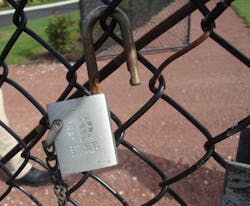Editor’s note: “Mitigating Mistakes” is a new SecurityInfoWatch.com column series from security consultant and author Paul Timm featuring photos of security vulnerabilities discovered in the field followed by a discussion on the problems they present to a facility’s security posture and how they can be addressed.
I started conducting security assessments in the late ‘90s and gradually worked my way up to assessing more than 100 facilities every year. While every facility is unique, I routinely encounter some common vulnerabilities. The idea of “Mitigating Mistakes” is to present a photo of a finding, explain why it is a problem, share a helpful security lesson, and offer a remedy. Let’s move forward together with the goal of making facilities safer.
Finding: While conducting security assessments, I periodically encounter an open padlock. That open padlock is often accompanied by a chain. A facilities employee may have simply forgotten to lock the unit. Open padlocks, however, can also represent the trading of security for convenience. In other words, it is possible that someone did not want to be bothered with using a key every time the lock was used.
Problem: A person with malevolent intent now has a tool, or tools, to use against the facility and its occupants. For example, the chain can be tied around exterior door handles and secured with the padlock to prevent egress from the facility.
Lesson: In Crime Prevention Through Environmental Design (CPTED), the principle of “Maintenance” addresses the expression of ownership of property. Maintenance issues, such as open padlocks, indicate a lack of control/order. Do not give the perception that you tolerate disorder! CPTED’s “Broken Windows Theory” warns that the presence of a broken window often leads to increased vandalism. The sooner broken windows are fixed, the less likely it is that such vandalism will occur in the future. A neat, ordered, well-maintained property conveys a sense of pride that actually reduces the risk of crime.
Remedy: Document a practice that requires padlocks be secured. If that practice is not being followed, consider replacing existing units with key-retained padlocks.
About the Author:
Paul Timm, Vice President of Facility Engineering Associates, is a board-certified Physical Security Professional (PSP), the author of School Security: How to Build and Strengthen a School Safety Program, and a nationally acclaimed expert in physical security. In addition to conducting numerous vulnerability assessments and his frequent keynote addresses, Paul is an experienced Crisis Assistance Team volunteer through the National Organization for Victims Assistance (NOVA). He is certified in Vulnerability Assessment Methodology (VAM) through Sandia National Laboratories and the ALPHAÔ vulnerability assessment methodology. He is also a member of ASIS International’s School Safety & Security Council and the Illinois Association of School Business Officials’ Risk Management Committee. Paul recently earned his Master’s degree from Moody Theological Seminary.



